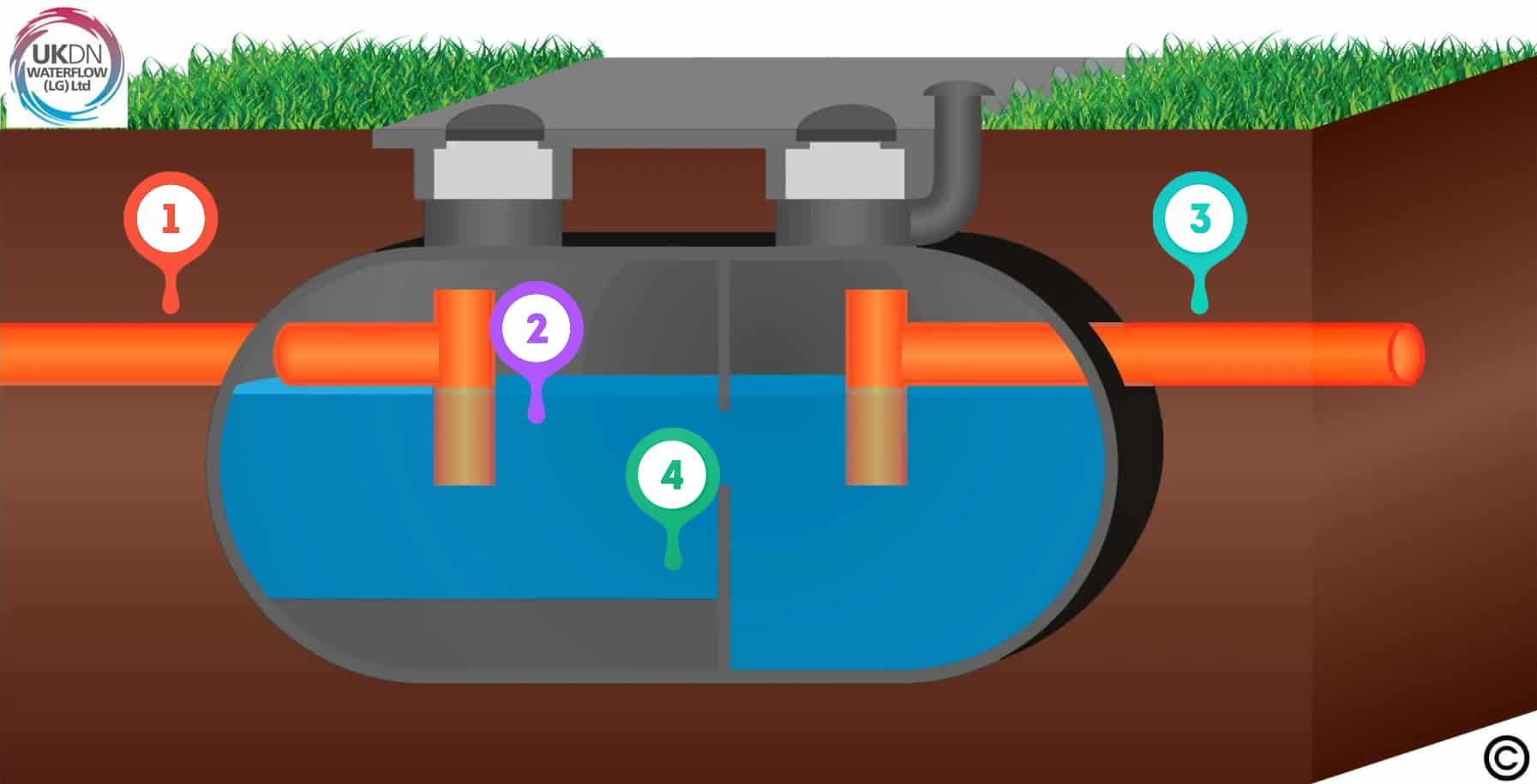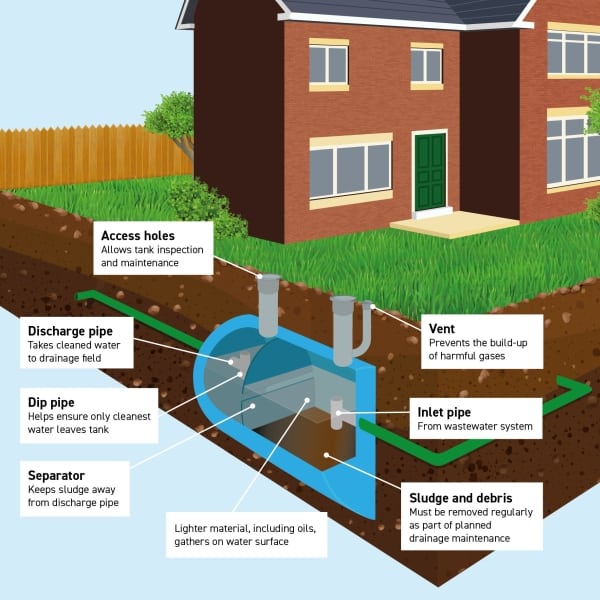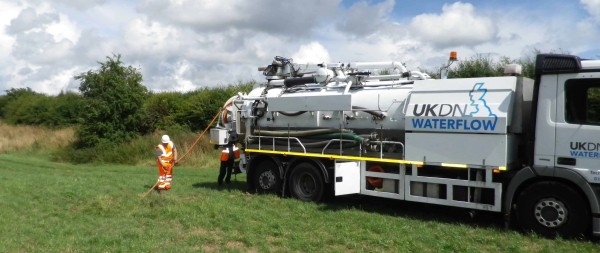A septic tank collects and treats wastewater at a property that is not connected to the mains sewer system and is, therefore, most commonly used in rural areas. The term ‘septic’ means ‘infected with microorganisms’; the tanks contain bacteria which break down organic waste.
The inclusion of a bacterial treatment mechanism is the difference between a septic tank and a cesspit, and these structures have both residential and industrial appliances.
Installed underground, a septic tank makes use of natural processes to treat the sewage it stores. Usually made up of two chambers or compartments, the tank receives wastewater from an inlet pipe.
If you’re in need of maintenance work or servicing on a Septic Tank, follow this link, otherwise read on to learn more about Septic Tanks, and how they can be emptied.
How does a septic tank work?
Once sewage from a drainage system reaches a septic tank, the following occurs:
- Wastewater enters the first chamber
- The wastewater separates over time. Solids settle at the bottom, while oils and greases form a layer of scum at the top, leaving a layer of relatively clear water remaining in the middle.
- Clarified wastewater enters the second chamber. It then exits via an outlet pipe into a septic drain field, also known as a seepage field or leach field
- The remaining scum and solids in the tank are broken down by naturally occurring bacteria and what is left should be professionally removed periodically.
After the, now treated, sewage exits the septic tank, it is released via pipes into the ground. Legal limitations exist on how much sewage can be discharged into the environment per day, and these limitations vary based on whether sewage is pumped into flowing water (5,000 litres) or directly into the ground (2,000 litres).
A special permit is required to surpass these volumes, which can be obtained through contacting the Environment Agency on 03708 506 506.
Septic Tank maintenance advice
Septic systems require relatively little maintenance, but septic tank owners need to observe certain rules to make sure the tank system operates effectively.
For example, the following items should never be flushed down the drain or toilet as these items should never enter a septic tank (see The Dirty Dozen):
- Food waste
- Fat, oil and grease
- Plastic bags
- Nappies
- Sanitary towels, including tampons, applicators and wrappers
- Cotton buds
- Condoms
- Bandages and plasters
- Baby wipes
- Medicines, needles and syringes*
- Cleaning wipes
- Razor blades
These items will block the inlet and outlet pipes, and also disrupt the biological separation process taking place within the tank itself.
Frequent de-sludging is important to ensure a build-up does not occur. Annual maintenance should focus on removing solids from the tank- and should only ever be carried out by a qualified sewage worker. Similarly, disposing of this waste should be conducted by a registered waste carrier.
Another general maintenance guideline is to avoid using an excessive amount of anti-bacterial agents. These agents can affect the flora needed to process the waste water, which may hinder the septic tank’s function.
Septic drain field treatment
Similarly, a few simple rules will keep septic drain or leach fields healthy:
- Protect the drain field by not covering it with structures, tarmac or contract
- Avoid planting trees or plants on the area, as their roots can damage the underground pipes
- Sow grass to help it absorb any discharged water
- Prevent anyone driving or parking over the field
More advanced maintenance tips include designing the drain field in such a way to avoid overloading it with rainwater. This can be done by channelling roof gutters and surface drains away from it, as well as reducing general water use within the property. Facilitating proper septic tank drainage is essential; both for the environment and to protect the property owner from any legal repercussions associated with poor practice.
Frequently asked questions around emptying septic tanks
The septic tank emptying process involves trained professionals de-sludging tanks and removing solid matter or waste. Here are some answers to the most commonly asked questions around septic tank emptying.
Why does a septic tank need to be emptied?
If left unmaintained, the solids and sludge contained in a septic tank can sometimes lead to blockages or effect the flow of the wastewater from your property. Septic tank cleaning, therefore, is important- as emptying your septic tank reduces the chances of blockages or any overflowing waste that could have an impact on the environment and your property.
How often does a septic tank need emptying?
Exactly how often a septic tank needs emptying depends on a range of factors, from the size of the tank to the amount of waste that is added it. Some need emptying every couple of years, while others can last for decades before needing to be emptied. Most manufacturers recommend emptying annually.
Following septic tank installation, you’ll most likely be provided with a maintenance guide – however we can advise you further if you have any outstanding questions.
How do you know when to empty a septic tank?
Emptying your septic tank regularly keeps it at the best possible condition for the water to flow effectively and the tank to operate correctly. Even if your tank isn’t full, it’s still recommended to empty it at least once a year.
If you are experiencing any of the issues below, you may need to get your septic tank emptied sooner rather than later:
- Pooling water around your septic tank – this could be down to a blockage within your tank that is forcing the liquid to the surface.
- Slow draining water from your household, including sinks and toilets – if you are unable to locate a blockage within your household drains, the blockage may lie with your septic tank.
- Unpleasant odours coming from the same area as your septic tank – a properly-maintained septic tank she not release any foul odours, so this could be warning sign of a serious issue like overflowing waste from your septic tank.
You can contact UKDN if you’re unsure about how often you need to empty your septic tank. The emptying process involves a vacuumation truck removing waste from the tank before transporting it to a treatment facility.
How long does it take to empty a septic tank?
Emptying a septic tank is a quick process, taking anything from 20 minutes to a couple of hours depending on the size of the septic tank and how full it is.
If you would like to find out how long it would roughly take to empty your septic tank, you can contact our team today and chat with one of our experts.
What legislation is there around emptying a septic tank?
Recent legislation (2019) affecting the emptying of septic tanks dictates that owners of septic tanks that discharge water directly into canals, ditches, or general surface water, must replace or upgrade their drainage by the 1st January 2020.
How do you empty a septic tank?
Emptying a septic tank should always been done by a fully qualified worker. Emptying will usually be done with a vacuum tank, also known as a vacuum tanker. The worker will attach a nozzle to the septic tank which will then begin to empty and clean the tank.
Do I need a septic tank?
A septic tank is a worthwhile investment especially for homes that often face drainage issues or don’t have access to main sewer lines. Looking after and maintaining your septic tank can ensure that you have the best quality drainage system with little issues.
How can UKDN Waterflow (LG) help?
If you are looking to install a new septic tank or to empty your current one, get in touch with UKDN Waterflow (LG) today. Our fully-qualified experts can help you safely empty your septic tank using vacuum tankers and the latest equipment. We operate nationwide so wherever you are in the UK, we are able to help maintain and get your septic tank working to its full potential.



